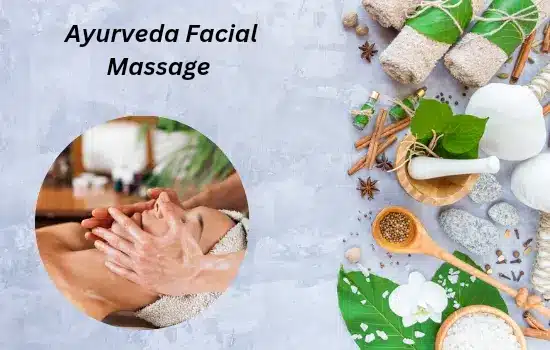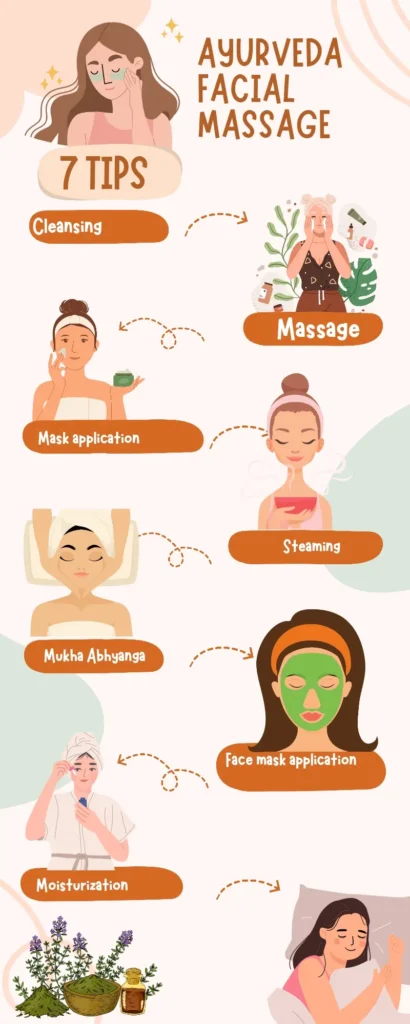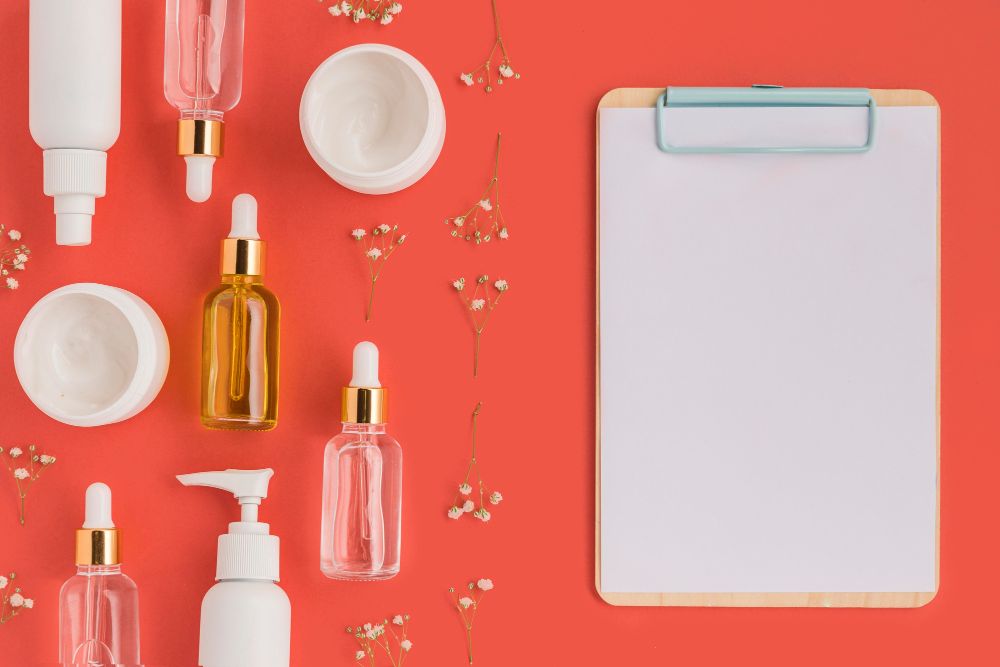Ayurveda Facial Massage: A Guide to Ayurvedic Face Care

In the busy world finding time to yourself is a luxury nowadays, particularly when it comes to skincare. Everyone wants beautiful and flawless skin. To get beautiful skin we purchase expensive beauty products and try different face packs. However, after spending money and a lot of time on our skin, we still face sensitive skin issues, acne spots, and saggy skin. We have no idea that all these products are not suitable or that they are a solution to our skin problems. Do you know?
The human body has energy, and when this energy is imbalanced, it can damage the skin and other parts of the body. You can balance this body energy with an Ayurveda facial massage and take care of your skin. Ayurveda facial massage is an old method. However, it stands out among a variety of modern treatments due to its many advantages and comprehensive approach. This traditional Indian therapy is a refreshing experience that improves your general well-being and the health of your skin. It is more than just a beauty routine.
What is Ayurveda Facial Massage?
Ayurveda means “the science of life,” It is the system of natural healing that is 5000 years old. To promote health and long life, it focuses on balancing the mind, spirit, and body. Ayurveda facial massage is a natural beauty treatment that uses facial oils, and herbal creams. This therapy lifts the face naturally, reduces the signs of aging, and gives you a radiant glow. This treatment includes different steps, such as exfoliation, herbal oil massage, steam to open pores, and customized face packs. It offers a healthy glow, tightens the skin, eliminates toxins, relaxes the facial muscles, and decreases the tan lines. It focuses on the delicate skin of the face by using specific techniques. This technique balances the body’s energy by tapping into energy points in your body, known as Marma points.
So, when we massage these points, it helps maintain the lymphatic system, circulatory system, and nervous system and improves your overall health. In this treatment, oils and herbal plants are used to provide radiant skin and relaxation.
Benefits of Ayurveda Facial Massage:
Following are the benefits of Ayurveda facial massage.
- It offers a natural facelift.
- Gives you radiant, glowing skin.
- Diminishes the signs of aging.
- Improves blood circulation in the face.
- Exfoliate the skin and remove dirt.
- Increases their skin hydration.
- Improves the skin texture.
- Tighten the skin.
- Removes toxins and impurities.
- Reduces stress and tension.
- Relax the facial muscles.
- Promote overall well-being.
- Enhance the mental clarity.
Radiant Skin:
Ayurveda facial massage stimulates circulation. It brings more oxygen and nutrients to the skin. This natural boost helps to enhance your complexion. So, give you a radiant, youthful glow. Regular sessions of Ayurveda facial massage can also help in detoxifying the skin. Moreover, it reduces puffiness, leading to a clearer, more even skin tone.
Anti-Aging Effects:
One more benefit of Ayurveda facial massage is its anti-aging properties. The massage promotes collagen production. It helps to decrease the wrinkles and fine lines. Gentle pressure was applied to Marma’s points. The pressure on these points helps in toning and lifting the skin and provides a natural facelift effect.
Stress Relief:
In addition to its skin benefits, Ayurveda facial massage helps to relax facial muscles. The gentle, rhythmic touch reduces stress and promotes a sense of peace. This not only improves your mood but also aids in better sleep, which is crucial for skin health.
Holistic Health:
Ayurveda teaches that the face reflects the health of the entire body. If your face looks fresh you look healthy. By stimulating different Marma points, facial massage can affect various organs and systems and improve your overall health. It is often used to reduce the symptoms of sinusitis, headaches, and even anxiety.
Types Of Ayurveda Facial Massage:
According to Ayurveda, the three life forces make up the energy of the mind and body. These are Kapha (water and earth), Vata (wind), and Pitta (fire). These are called doshas. Following are the three types of Ayurveda facial massage according to the skin type.
- Kapha Balancing Facial Massage
- Pitta Balancing Facial Massage
- Vata Balancing Facial Massage
Kapha Balancing Facial Massage:
Kapha skin refers to oily skin with large pores. It also looks pale and cool to the touch. Kapha balancing facial massage is beneficial for people with oily or acne-prone skin. It promotes blood circulation and reduces excessive fluids and oils. In this massage, herbal powders, face packs, and steam are used. Gentle strokes in massage increase blood circulation. This deep tissue massage tightens the skin.
Essential oils: Different essential oils used in Kapha balancing facial massage are Eucalyptus, rosemary, and frankincense oils.
Herbs for Facial:ginseng and guggul
Related Post: Best skin tightening Herbs
Pitta Balancing Facial Massage:
According to Ayurveda Pitta skin is a sensitive skin type. It is more prone to redness and inflammation. People with this skin type suffer from rosacea and sunburn easily. Pitta balancing facial massage reduces redness, inflammation, and toxins. It helps in soothing and cooling the skin. This massage uses soft strokes to calm the skin. Moreover, it uses cool massage tools and cold compressors. This massage hydrates to calm the irritated skin.
Essential oils: Lavender and Sandalwood Chamomile are used in this type of massage because they have cooling and soothing properties.
You may also like the Benefits of Face oils
Vata Balancing Facial Massage:
Vata’s skin type is dry and dehydrated. It is more prone to fine lines and wrinkles. This facial massage nourishes, hydrates, and warms the skin. Moreover, it increases the skin’s elasticity. In this massage type, slow strokes nurture the skin and relax the skin muscles.
Essential Oils: Sesame oil, Almond oil, and geranium are excellent oils for nourishing the vata skin.
How to Perform Ayurveda Facial Massage?
Here are details about how to perform an Ayurveda facial massage. It includes traditional techniques and natural ingredients, which promote balanced, healthy skin and overall health.

Step 1-Cleansing:
The first step is cleansing. For cleansing herbal paste made with natural ingredients is used according to skin type. To make the paste, mix the suitable herbal powder with 1 tsp of milk, honey, and rose water. Apply this paste to your skin. Exfoliate for 10-20 minutes to remove dirt and impurities. After this rinse your face with cool water.
Step-2 Massage:
After cleansing and gentle exfoliation apply ayurveda facial oil according to your dosha. Massage your face in a circular motion by using your fingertips. Allow the oil to penetrate deep into the skin. Repeat the process three times for relaxation and better absorption.
Step-3 DIY Face Pack: Mask Application
Make a creamy mixture of milk cream and Ayurveda herbs like neem, amla, and turmeric. Apply the creamy paste to your face. This face pack is nutrient rich so it nourishes your skin deeply. Milk cream hydrates and brightens your skin. Because milk cream contains fats that are excellent moisturizers, it makes your skin soft and removes dead skin. Neem and turmeric have anti-bacterial and healing properties, so they help to treat skin infections. Amla targets the signs of aging and removes blemishes and dark spots. It is a rich source of vitamins C and E. In addition, it also protects the skin from sun damage.
After 30 minutes remove the face pack with wet wipes or cloth.
Step-4 Steaming:
Cover your eyes with cool and moist cotton and get steam on your face with a facial steamer. Steam helps to open your skin pores and improves blood circulation. It also facilitates sweating and rejuvenates your skin.
Step-5 Nourishing the Skin With Medicated Oil:
It is a post-steaming step. This step is called Mukha Abhyanga. It is a 30-minute facial massage with specific medicated Ayurveda oils. This step includes the massage of a pressure point that relaxes the facial muscles.
Step-6 2nd Face Pack Application:
After Abhyanga, the other face pack is applied. The mask is made with ingredients that are best suitable for your skin. For oily skin mix 1tsp of honey and curd with multani mitti. Take a few fresh mint leaves, crush them, and add to the mixture. Apply this face pack for 25 minutes. After that rinse it off with water.
For acne skin, take a powder of neem leaves, add a pinch of turmeric and some drops of lavender oil. Make a smooth paste and apply it to your face for 30 minutes. Let the face pack dry. Wash it off with lukewarm water.
The best ayurveda face pack is made up of sandalwood oil and rice flour. Sandalwood helps in reducing redness and inflammation. Rice flour contains antioxidants. So, this face pack gives your skin a healthy glow.
For relaxation rose petals and cucumber slices are placed on your eyes. Wash your face and pat it dry.
Step-7 Moisturizing and Precaution:
The last step is the use of moisturizing oil and Ayurveda facial cream for extra moisturization. Always consult with the Ayurveda expert practitioner to choose the right and suitable herbs and oils according to your skin’s needs. Some Ayurveda oils for the face are coconut, sesame, castor, and almond oils.
People who want to incorporate ayurvedic massage in their skincare routine can learn simple techniques to perform at home. Start with basic strokes and gradually incorporate Marma point stimulation. Use natural oils like coconut, sesame, or specially formulated Ayurvedic oils that suit your skin type.
Marma Points: Deepening Your Self-Care Routine
For those looking to deepen their self-care routine, Ayurveda offers the massaging technique of marma points on the face. Each point is linked to different physical and mental aspects of health. It helps to balance energy and improve systemic functions:
-Chin and Mouth Corners: Linked to reproductive health and metabolism.
-Nose and Cheekbones: Associated with sinus health and lung function.
-Eyebrows and Temples: Connected to liver, spleen health, and stress relief.
-Forehead and Crown: These points are centers for mental and spiritual balance.
Conclusion
Ayurveda facial massage is more than just a beauty treatment. This traditional massage promotes longevity, beauty, and balance. Whether you’re looking to enhance your skin, reduce stress, or adopt a more holistic approach to health, this ancient practice offers a timeless solution. Let’s incorporate the gentle, healing touch of Ayurveda facial massage to give your face a healthy glow.

